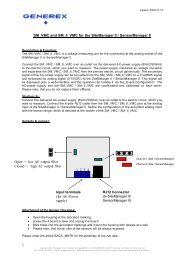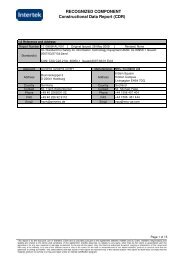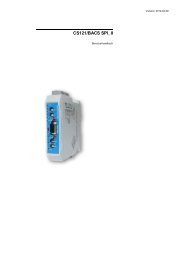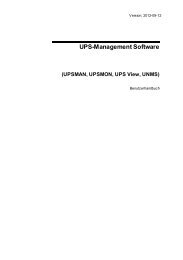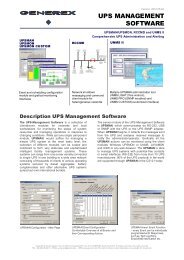BACS® - Generex GmbH
BACS® - Generex GmbH
BACS® - Generex GmbH
Create successful ePaper yourself
Turn your PDF publications into a flip-book with our unique Google optimized e-Paper software.
The patented BACS „Battery Analysis & Care<br />
System” now the 3 rd generation is the most advanced<br />
product on the market today providing an Ethernetnetwork<br />
integrated battery monitoring and<br />
management system. Using web-management<br />
technology it checks the internal resistance, the<br />
temperature and the voltage of every single<br />
accumulator sequentially.<br />
Through our patented EQUALISATION process it<br />
corrects the charging voltage of each accumulator<br />
individually. The accumulators are kept in the optimal<br />
voltage operating range.<br />
The constant monitoring and controlling of the<br />
individual charging voltages for each accumulator<br />
guarantees the availability of the battery at all times –<br />
making the Achilles Heel of a UPS systems (or any<br />
other battery powered device) a thing of the past!<br />
In addition, it can manage environmental<br />
measurements (temperature, humidity, acid fill level,<br />
hydrogen gas concentration, etc.) and appliances<br />
(UPS, inverters and other devices).<br />
Copyright of the European Union is effecti ve (Copyright EU) (c) 2012 GENEREX Systems <strong>GmbH</strong>, H amburg, Ger many, All rights reserved<br />
TEL +49( 40)22692910 - EMAIL gener ex@generex.de - WEB www.generex.de (This and all other product datasheets ar e available for downl oad.)<br />
Version: 2012-11-27<br />
BACS ®<br />
BACS ® - Battery Analysis & Care System<br />
3 rd Generation Battery Management System<br />
� Monitoring, individual charging /discharging & alarm system for accumulators<br />
� Avoid unnoticed or unexpected battery failures, extending the battery lifespan and<br />
preserving the reliability of the complete system<br />
BACS ® w eb server<br />
displays here the<br />
battery status of<br />
140 accumulators.<br />
Any change in<br />
impedance,<br />
temperature and<br />
voltage is displayed<br />
and stored. Status<br />
LEDs show a<br />
change of color if<br />
any accumulator<br />
drifts beyond<br />
thresholds.<br />
Discharge process displayed via the BACS VIEWER software<br />
shows the voltage drop of several batteries during a discharge,<br />
unnoticed by the UPS. In a later stage these accumulators<br />
would make the complete system collapse.<br />
BACS is the ideal system for all lead-acid based<br />
accumulators (open/wet cells, maintenance free, gel,<br />
AGM), etc.<br />
Charging process of accumulators with BACS ® patented<br />
Equalisation – the charging of battery 3 is capped to prevent<br />
overcharging that could cause gassing. Supply of charging<br />
energy to battery 2 is continued and boosted until the target<br />
charging voltage is obtained. Battery 1 performs ideally and<br />
is not regulated.
BACS ® Features at a Glance<br />
� Monitoring and regulating the charging<br />
process: The system is designed for monitoring and<br />
regulating lead-acid based accumulators in a group of<br />
batteries.<br />
� Individual voltage regulation: BACS ® is regulates<br />
the voltage supply for every accumulator from the<br />
charger/UPS. This results in a homogenous set of<br />
accumulators with at most capacity and lifespan. This<br />
regulation process is patented as “EQUALISATION”.<br />
� Avoid overcharging: Through the<br />
EQUALISATION process the unnoticed overcharging<br />
of individual batteries (gassing, dry-out, thermal<br />
runaway) is prevented.<br />
Oscilloscope graph of battery voltages at an Equalizing<br />
process: The voltages of the 3 batteries behave different<br />
because of the regulating influence of the BACS modules.<br />
The ideal harmonic charging curve w ill be archieved for<br />
every battery in the string.<br />
� Avoid undercharging: Through the<br />
EQUALISATION process the unnoticed<br />
undercharging of individual batteries (sulphation, loss<br />
of capacity) is prevented.<br />
� Indicator of battery problems: Typical battery<br />
problems like sulphation, corrosion, gassing, dry-out,<br />
thermal runaway etc. are visible through a rise of<br />
Impedance and temperature.<br />
� Avoid sulphation : Sulfation is a typical problem<br />
for UPS batteries because they are consistently held<br />
at a float charge level for a long time. Its not<br />
guaranteed that ALL accumulators have really been<br />
fully charged when the UPS charge switches from<br />
boost charging to float charging. The result maybe<br />
that some accumulators are overcharged, while<br />
others have never been fully charged.<br />
EQUALISATION avoids sulphation through the<br />
process of bringing the overcharged and<br />
undercharged accumulators to a balanced voltage<br />
level.<br />
� Show stratification: BACS warns through<br />
increasing impedance and drifting Voltages of a<br />
possible stratification of the electrolyte. The acid-gelwater<br />
mix requires from time to time a discharge<br />
process to reverse the stratification of these parts due<br />
to gravity. Through the discharge process the<br />
stratification can be removed and the BACS shows<br />
this effect through a lower impedance and improved<br />
equalizing.<br />
� Protection of neighbour batteries: BACS avoids<br />
damages on neighbouring accumulators through the<br />
Equalisation process in balancing all individual<br />
voltages of the accumulators.<br />
� Battery alert system : Through monitoring of key<br />
parameters of the accumulators and measuring<br />
against set thresholds, the system is able to give you<br />
pre-warnings via audible, visible and network<br />
messages that attention is required.<br />
� Battery breaker switching at thermal runaways:<br />
Through the embedded dry contact output the BACS<br />
system may trip the battery breaker in case of high<br />
battery temperature. A stringwise battery<br />
disconnection is possible.<br />
The GX_R_AUX Module provides 4 relay contacts plus 4<br />
digital inputs. One of the standard functions is the control of a<br />
battery breaker to avoid a thermal runaway. The digital inputs<br />
read eg. The battery breaker status and display this in the<br />
BACS Webinterface. Any other alarm device may be<br />
connected to the outputs (eg. Alarm buzzer, breaker etc.) or<br />
digital inputs of the GX_CON_R and the device itself can be<br />
placed anywhere w ithin the BACS bus system – ideally close<br />
to the alarm devices which makes the installation easy.<br />
� Increase battery capacity: BACS ® guarantees,<br />
through EQUALISATION, a full charge level and the<br />
optimal capacity of a battery system.<br />
� Early warning to replace batteries: Through<br />
impedance trending you can see in the early stage<br />
that some accumulators are damaged or simply<br />
weaker than others. The earlier accumulators are<br />
replaced the better for an increased lifetime of the<br />
complete battery system !<br />
� Extension of service life up to 30%: The service<br />
life of all accumulators in a string depends on the<br />
weakest member, the weakest battery. Typically the<br />
service life of accumulators in a UPS are around 50-<br />
60% of the manufacturer design life. By Equalizing all<br />
batteries are kept constantly in their ideal voltage<br />
window so that all negative influences of wrong<br />
charging voltages and currents within the string are<br />
eliminated. Through this constant „care“ process<br />
through Equalizing, it is possible to increase the<br />
service life up to 30%, probably more. At ideal<br />
operating conditions it is possible to keep batteries in<br />
a string operating until the design life, and beyond.<br />
From scientific researches it has been proofed that<br />
Equalizing increases the service life for at least 10%.<br />
From our testresults we can proof today that more<br />
than 30% service life has been reached. We hope to<br />
be able show that with Equalizing even more than the<br />
design life of 5 years is possible. (2 BACS systems<br />
running since 2004 with Panasonic 5 year design life<br />
batteries, already 2 years longer in operation than the<br />
design life and still performing.<br />
Copyright of the European Union is effecti ve (Copyright EU) (c) 2012 GENEREX Syste ms <strong>GmbH</strong>, H amburg, Ger many, All rights reserved<br />
TEL +49( 40)22692910 - EMAIL gener ex@generex.de - WEB www.generex.de (This and all other product datasheets ar e available for downl oad.)
� Power & Environmental alert system : The BACS<br />
system monitors environmental parameters<br />
(temperature, humidity, hydrogen gas concentration,<br />
acid fill level, DC current, etc.) and UPS system data.<br />
This information including alarm alerts is available via<br />
a mix of multiple communication systems.<br />
� Maintenance: A BACS system improves the<br />
service quality by providing remote monitoring<br />
through Internet, VPN or other network for<br />
downloading real time data and battery history for<br />
analysis. Single, individual battery tests are now<br />
possible without the effort to disconnect batteries from<br />
the group. Maintenance and battery testing are able<br />
to take place at time, under real operating conditions,<br />
without downtime of the system!<br />
� UPS SNMP & MODBUS manager : A BACS<br />
system includes a full qualified UPS/SNMP and<br />
MODBUS manager - compatible to any UPS vendor<br />
in the market! A unique function in the market of BMS<br />
system.<br />
� MODBUS/PROFIBUS/LONBUS/SNMP : A BACS<br />
system allows MODBUS clients to read the data of<br />
the BACS system through IP and RS232 (optional<br />
through RS485) and through SNMP. Through optional<br />
converters a conversion to PROFBIS and LONBUS is<br />
possible. From 2013 a BACnet converter will be<br />
available.<br />
�<br />
� Free BACS VIEW ER analysis software : Provides<br />
graphical BACS data analysis and reports!<br />
Flash ROM capacity for battery history depending on no. of BACS modules in the<br />
system<br />
No. Of BACS<br />
Modules<br />
3112<br />
Log range in<br />
flash ROM<br />
(in days)<br />
10<br />
20<br />
1556<br />
30<br />
1037<br />
40<br />
778<br />
50<br />
622<br />
60<br />
519<br />
70<br />
445<br />
80<br />
389<br />
90<br />
346<br />
100<br />
311<br />
110<br />
283<br />
120<br />
259<br />
130<br />
239<br />
140<br />
222<br />
150<br />
207<br />
Copyright of the European Union is effecti ve (Copyright EU) (c) 2012 GENEREX Syste ms <strong>GmbH</strong>, H amburg, Ger many, All rights reserved<br />
TEL +49( 40)22692910 - EMAIL gener ex@generex.de - WEB www.generex.de (This and all other product datasheets ar e available for downl oad.)<br />
160<br />
195<br />
The free BACS VIEWER software shows the EQUALISATION<br />
of a battery within a string or 32 batteries (shown as bold violet<br />
line) during a discharge/rechargingprocess .<br />
BACS EQUALISATION avoids that this violet accumulator<br />
gets overcharged, while other accumulators still require further<br />
charging.<br />
This tables shows the capacity of the BACS WEBMANAGER flashrom for the BACS data during float charging operation. (Autosave of<br />
battery data every 20 minutes). At a discharge or any other alarm, the autosave intervall is drastically reduced which increases the data<br />
to save on the flash rom to provide very precise data for the analysis through the BACS VIEWER. The number of BACS modules and the<br />
number of discharges determines the available capacity. The table above shows the storage of battery history in days on the flashrom,<br />
assuming that there is no discharge and the system operates normally. This amount of data is available for the transfer to other storages<br />
in the netw ork. Older files get overwritten and only the latest battery data is kept on the flashrom. We recommend to use the BACS<br />
VIEWER software for regular downloads of battery history and storage on a remote computers harddisk.<br />
170<br />
183<br />
180<br />
173<br />
190<br />
164<br />
200<br />
156<br />
210<br />
148<br />
220<br />
141<br />
230<br />
135<br />
240<br />
130<br />
250<br />
124<br />
260<br />
120<br />
270<br />
115<br />
280<br />
111<br />
290<br />
107<br />
300<br />
104<br />
310<br />
100<br />
320<br />
97<br />
330<br />
94
BACS Description<br />
The reliability of an accumulator based power<br />
supply can only be guaranteed when the<br />
availability of each accumulator is at 100%<br />
capacity all of the time!<br />
The BACS ® battery modules have instruments for<br />
taking exact measurements of the internal resistance,<br />
temperature and voltage which are valuable for<br />
making a precise analysis of each battery. The data is<br />
transferred through a bus system to the BACS<br />
WEBMANAGER which is at the same time the<br />
manager for UPS, inverters, environmental sensors<br />
and other devices.<br />
The BACS WEBMANAGER acts as the central<br />
control unit by gathering, evaluating and storing all<br />
information on its internal flash MEMORY. A display<br />
shows the actual status of the accumulators, a 2 nd<br />
display shows the actual UPS data and a 3 rd display<br />
shows environmental data and alarm contacts status.<br />
The web browser interface of the system is designed<br />
for easy configuration, displaying all system values<br />
and events, a flexible EVENT MANAGER is the<br />
programming interface for automatic reactions in case<br />
of alarms.<br />
The BACS WEBMANAGER compares constantly the<br />
individual accumulator voltage in relation to the<br />
current voltage level of the overall sys tem. This value<br />
is sent to every BACS ® module which starts counter<br />
steering. This process is called “EQUALISATION” and<br />
ensures that the voltages of all accumulators are<br />
balanced.<br />
The BACS ® system limits the charge to the<br />
overcharged accumulators to avoid gassing and the<br />
drying out that would occur from this action. Each<br />
individual accumulator receives an optimal charging<br />
voltage through this EQUALISATION process.<br />
Limiting the charging voltages of the accumulator<br />
increases the durability and reliability of the whole<br />
system considerably.<br />
Rising internal resistance of an accumulator due to<br />
corrosion or sulphate deposits will trigger an alarm.<br />
Alarm values can be configured to match the type of<br />
battery. This „early warning system“ makes it possible<br />
to warn users (by email, email-to-SMS, network<br />
message, SNMP, RCCMD, MODBUS, PROFIBUS,<br />
LONBUS etc.) far in advance about battery<br />
weaknesses before it is too late. For instance, should<br />
sulfation increase internal resistance, the user can<br />
reverse this process with a series of discharging and<br />
charging cycles. The effect of such „battery training”<br />
on the internal resistance can be read immediately!<br />
In addition to internal resistance, the values for<br />
voltage, temperature, regulating activities and the<br />
number of charging / discharging cycles are<br />
constantly monitored and compared with preset<br />
thresholds. When any of the threshold values are<br />
exceeded, corresponding alarms will be<br />
communicated using the network connection, modem<br />
(optional), email, SMS, SNMP, RCCMD, MODBUS<br />
and (optional) PROFIBUS or LONBUS.<br />
At the BACS-Manager an alarm buzzer acoustically<br />
warns the users. An alarm LED on the module and on<br />
the BACS-Manager shows the alarm optically.<br />
The BACS WEBMANAGERs are equipped with a<br />
large flash MEMORY or SD memory cards that can<br />
log all system data for a duration of at least 6 months<br />
and up to 3 years dependent of the size of the<br />
system. All data can be downloaded and archived<br />
over the network in order to free-up storage capacity<br />
for further data logging and for analysis using the<br />
BACS VIEWER software or other graphical tools.<br />
The alarms for other devices connected to the BACS<br />
WEBMANAGER (e.g. UPS) are also logged in<br />
separate files with a date and time stamp and shown<br />
in the web interface. The BACS WEBMANAGER is<br />
equipped with a real-time clock for precise data/time<br />
stamps in the log files, additionally the system time is<br />
automatically synchronized with a network time server<br />
(SNTP).<br />
BACS Viewer shows the<br />
individual battery voltage of<br />
all accumulators at the end of<br />
a discharge. The red dotted<br />
line shows the voltages when<br />
pow er has returned. In the<br />
low er bar graph is shown<br />
which accumulators have<br />
collapsed earlier than others<br />
and have been discharged. to<br />
a very low level. These<br />
accumulators are a risk to the<br />
complete system.<br />
Copyright of the European Union is effecti ve (Copyright EU) (c) 2012 GENEREX Syste ms <strong>GmbH</strong>, H amburg, Ger many, All rights reserved<br />
TEL +49( 40)22692910 - EMAIL gener ex@generex.de - WEB www.generex.de (This and all other product datasheets ar e available for downl oad.)
Accumulators in UPS applications<br />
In a typical UPS battery installation there could be<br />
many accumulators (singles cells, multiple cells like<br />
6Volt 12Volt accumulators) that are connected in<br />
series to archive a very high voltage in the string.<br />
Modern UPS with IGBT Rectifiers are working very<br />
efficiently, but require a high string voltage, compared<br />
to the string voltages of older type Transformer UPS<br />
systems. This increase in string voltage has in turn<br />
increased the number of accumulators required within<br />
a string. It is not unusual to have 800 Volts or more<br />
within a string of accumulators – with the equivalent<br />
number of batteries/cells. Modern UPS tend to have<br />
to use many more accumulators per string, but<br />
smaller capacities to avoid more space in the server<br />
rooms.<br />
Short battery life in UPS usage: The more<br />
accumulators that are in a string, the more cables,<br />
connectors, distances are involved which leads to<br />
higher and lower potential within the battery string.<br />
The more resistive materials accumulator placement,<br />
length of cabling etc. the more differ the impedances<br />
within the accumulators of this string and the more the<br />
charging levels are different. This effect gets over the<br />
time so dramatic that it is even visible from the<br />
different voltage levels of the accumulators withing<br />
the string. The differences will in the beginning in the<br />
10th's of a volt but over time an accumulator that is at<br />
the stated float of 13.60 Volt will drop incrementally<br />
as other accumulators rise as the current will flow<br />
elsewhere.<br />
Taking in to play that all accumulators are not created<br />
equal, it is just logic that in a string their individual<br />
accumulators/cells will never get the correct<br />
amount of charge they need to prevent sulfation and<br />
dry out as well as premature aging and failure.<br />
For years, this was simply commonly accepted and<br />
nobody ever thought it could be a problem to have<br />
voltage difference in a battery string of 1 Volt or more.<br />
Since there was no technical solution the UPS maker<br />
did not focus on this problem and simply<br />
recommended to replace accumulators far earlier<br />
than the designed lifetime to reduce the risk for<br />
battery failures. Nowadays it is commonly accepted<br />
that in a UPS application the lifetime of a 12Volt<br />
battery is just 50%-60% of the design life.<br />
Customers who have suffered from failing UPS<br />
batteries did not feel comfortable just to change<br />
batteries more often since it would not guarantee a<br />
safe operation with the new batteries that could<br />
collapse without warning. A high string voltage UPS<br />
cannot tolerate a missing accumulator and the<br />
complete system collapses at a single point of failure.<br />
UPS makers have counteracted this issue by offering<br />
the customers redundant UPS systems with at least 2<br />
strings of accumulators. This reduces the risk<br />
drastically, but has several disadvantages (Costs,<br />
space for installation, higher service efforts) – and still<br />
it is no guarantee – the user can not see what is going<br />
on in the battery strings and only theoretically can<br />
reduce the risk by adding as many strings as<br />
possible.<br />
To reduce the risk of unnoticed battery failures and<br />
loss of backup, customers installed automatic transfer<br />
switches to their redundant UPS and Generators as<br />
the main backup in case of a power failure.<br />
Also this extremely costly solution is still not safe<br />
since - all Generators need a few seconds to start, so<br />
there always will be a number of accumulators<br />
between the UPS and Generator. Also the Generators<br />
starter battery is another risk factor – and the battery<br />
remains the Achilles Heel of every UPS or other<br />
battery backup system.<br />
Knowing this, customers began to install monitoring<br />
systems “BMS” for batteries. Such systems should<br />
not only show why batteries are failing (Voltage<br />
differences, Rising impedance etc.) but also start<br />
automatic counteractions. BACS is the only system<br />
on the market which does not only “monitoring”<br />
but is regulating the system through its<br />
EQUALISATION!<br />
The following screen shows the battery voltages of a<br />
batteries connected in a string that would be found in<br />
every UPS system today, which is not managed by<br />
BACS. The individual voltages after 5 years differ in a<br />
a window of more than 1.8 Volt.<br />
BACS VIEWER screenshot:<br />
An UPS w ith 64 * 12Volt<br />
batteries after 5 years in<br />
operation shows that voltages<br />
have drifted within a large<br />
window of 1.8Volt between the<br />
low est and the highest battery.<br />
Voltages without the<br />
Equalisation process after 5<br />
years in operation.<br />
Follow ing pictures shows the<br />
same Batteries, now with<br />
EQUALISATION<br />
Copyright of the European Union is effecti ve (Copyright EU) (c) 2012 GENEREX Syste ms <strong>GmbH</strong>, H amburg, Ger many, All rights reserved<br />
TEL +49( 40)22692910 - EMAIL gener ex@generex.de - WEB www.generex.de (This and all other product datasheets ar e available for downl oad.)
Due to individual differences in the accumulators the<br />
voltages are not identical. The longer such differences<br />
have been in place and the accumulators have not<br />
received a separate, balancing charge, the more the<br />
accumlators start drifting until they finally show a<br />
difference of 1 Volt or more – like in the screenshot of<br />
such 5 year batteries above.<br />
With the introduction of the BACS patented<br />
EQUALISATION technology in 2004 the system is<br />
now able to eliminate all the voltage/charging<br />
differences in a<br />
A general description about the Equalisation principle<br />
and explanation why this extends battery life<br />
drastically and extends cycle life by about a factor of 3<br />
is scientifically explained in the INTELEC Paper 32.1<br />
“Life Extension through charge Equalisation of Lead-<br />
Acid Batteries” by Philip T. Krein Member of IEEE<br />
string of accumulators. through its “Equalisation”<br />
process. The Equalisation process brings all<br />
accumulators to 1/100th of Volt for each accumulator<br />
on the string, despite its interconnections or location<br />
in that string and keeping the accumulator at full<br />
charge and within the stated manufacturing float<br />
voltages.<br />
The following screen shows the voltages of the same<br />
5 year old accumulators a few hourse after BASC<br />
technology has started its Equalisation process.<br />
BACS VIEWER screenshot:<br />
The same 5 year old battery<br />
string above, now with<br />
BACS Equalisation. Within a<br />
few hours the Equalisation<br />
brings all accumulators to<br />
within 100 th volt of each<br />
other and keeping the<br />
accumulators at the<br />
manufacturers stated float<br />
charge.<br />
BACS Equalisation process<br />
is correcting the negative<br />
influence that cause<br />
premature accumulator<br />
failures due to voltage and<br />
impedance differences<br />
within a string.<br />
Based on scientific expertise and GENEREX own<br />
investigations from 2002 to 2004 the BACS patent<br />
has been established.<br />
Copyright of the European Union is effecti ve (Copyright EU) (c) 2012 GENEREX Syste ms <strong>GmbH</strong>, H amburg, Ger many, All rights reserved<br />
TEL +49( 40)22692910 - EMAIL gener ex@generex.de - WEB www.generex.de (This and all other product datasheets ar e available for downl oad.)
BACS System Components<br />
BACS C Modul & Kabel<br />
Ein Diagram of a BACS Module installation:<br />
A calibrated Measuringcable w ith 2 High-<br />
Voltage fuses connected to the positive and<br />
the negativen Batterypoles uses a 4-string<br />
wire for measuring the individual battery<br />
data.<br />
The BACS module measures through an<br />
integrated sensor the surface temperature<br />
of the accumulator, the voltage and the<br />
impedance.<br />
The BACS module is available in 5 different<br />
types: 16Volt, 12Volt, 6Volt, 2Volt and for<br />
NiCd, NiMH and Lithium Ion battereis w ith a<br />
widerange of1.2 V- 3Volt.<br />
At EQUALISATION mode, the thermal<br />
energy is transferred through the cooling<br />
fins to the environment, until the process<br />
has finished.<br />
The status is shown at an LED on the<br />
frontpanel.<br />
Simple installation or retrofitting through<br />
Velcro tapes and bus cables.<br />
BACS WEBMANAGER<br />
2 External and 1 UPS Slot-Version<br />
Management of up to 330 BACS C-Modules<br />
in up to 10 parallel strings<br />
Includes a full qualified UPS-SNMP &<br />
MODBUS-Manager at COM 1 for the<br />
Monitoring of a UPS/Inverters/Rectifiers or<br />
other devices w ith a serial interface.<br />
COM 2 for optional environmental sensors<br />
(e.g. temperature, humidity, current, acide<br />
fill level, etc.)<br />
1 programable alarm relay output , 1 alarm-<br />
LED, 1 alarm-buzzer, mute button<br />
Integrated Web-Server for status dispaly<br />
configuration of all alarm treshholds (battery<br />
-impedance, -voltage, -temperature, UPS<br />
alarms, environmental alarms, etc. Network<br />
messaging system (E-Mail, SMS,<br />
SNMP, RCCMD, MODBUS and (optional)<br />
PROFIBUS, LONBUS, BACnet<br />
Datalogger for all measuring data, (optional)<br />
currentsensors for charge- and discahrge<br />
current measuring.<br />
Compatible to UNMS monitoring software<br />
and LED Matrix remote display.<br />
Integrated DIN-rail mounting on all external<br />
manager types.<br />
Copyright of the European Union is effecti ve (Copyright EU) (c) 2012 GENEREX Syste ms <strong>GmbH</strong>, H amburg, Ger many, All rights reserved<br />
TEL +49( 40)22692910 - EMAIL gener ex@generex.de - WEB www.generex.de (This and all other product datasheets ar e available for downl oad.)
BACS Modules - Technical Data and Dimensions<br />
BACS II C20 module with<br />
external temperature sensor f or<br />
12V accumulators between 7–<br />
300 Ah, with indiv idual block<br />
v oltage regulation, LED status<br />
and error display , and bus cable<br />
connections.<br />
Construction<br />
Pow er<br />
consumption<br />
from battery<br />
Measuring precision<br />
Reference HIOKI<br />
^ Interfaces<br />
Display<br />
Housing<br />
Dimensions, Weight<br />
Operating condition<br />
Int. Protection Rating<br />
Designed for ATEX 94<br />
(Explosive Atmospheres)<br />
High Voltages Security tested<br />
MTBF (calculated)<br />
Voltage range<br />
RI range<br />
Equalisation pow er<br />
Voltage range<br />
RI range<br />
Equalisation pow er<br />
Measuring value<br />
RI range<br />
Equalisation pow er<br />
Measuring value<br />
RI range<br />
Equalisation pow er<br />
Measuring value<br />
Equalisation pow er<br />
Measuring value<br />
Equalisation pow er<br />
BACS ® Modules REV 2 & REV 3<br />
Measuring modules w ith Equalisation<br />
BACS patent no.: DE 102004013351.4<br />
Consumption at normal operation: 15-20mA<br />
Consumption at „Sleep Mode“: < 1mA (from REV 2.2)<br />
Internal resistance : < 10 % at C40, < 5% at C20/30<br />
Voltage : < 0,5 %<br />
Temperature: < 5 %<br />
2x RJ10 for BACS II battery bus<br />
Internal RS232 bus interface<br />
1x button for the addressing<br />
Temperature sensor -35 bis + 85 °C<br />
Optical display LED (alarms red/green, mode red/green)<br />
ABS housing (UL certified, flame retardant, cooling fins)<br />
REV 2 = 80 x 55 x 27 mm = 3,15 x 2,17 x 1,06 in. (B x H x T), 75g<br />
REV 3 = 55 x 80 x 24 mm = 2,17 x 3,15 x 0,94 in. (B x H x T), 45g<br />
Temperature 0 - 60°C, max. humidity 90%, not condensing<br />
REV 2: IP 30, (coated version optional)<br />
REV 3: IP 42 coated against dust and condensate)<br />
REV 2.2 – Group 2 Cat.3, Zone 2, T1<br />
REV 3.0 – Group 2 Cat.2, Zone 1,21, T3<br />
Protection against high ohmic batteries fault voltages up to 150 Volt (fuse<br />
opens, no damages on BACS module REV 3.1. At higher voltages the<br />
fuse opens, but BACS module is damaged. All REV 3.1 modules are<br />
designed for fault voltages up to 600 Volt<br />
70.000 hours (8 years)<br />
Module BACS ® C20<br />
Order No. BACSC20<br />
REV 3 - Module for 12Volt 7-600Ah lead batteries (UL certified)<br />
7V – 17V<br />
0.5-60mOhm<br />
0.15 A<br />
Module BACS ® C23<br />
Order No. BACSC23<br />
REV 3 - Module for 16Volt 7-600Ah lead batteries,<br />
7V – 21V<br />
0.5-60mOhm<br />
0.12 A<br />
Module BACS ® C30<br />
Order No. BACSC30<br />
REV 3 - Module for 6Volt 7-900Ah lead batteries.<br />
4.8V – 8.0V<br />
0.5-60mOhm<br />
0.3 A<br />
Module BACS ® C40<br />
Order No. BACSC40<br />
REV 3 - Module for 2Volt 7-5000Ah lead batteries (UL certified)<br />
Voltage and Temperature measurement<br />
1.25V – 3.2V<br />
0.05-2mOhm<br />
0.9 A (at 2.27V)<br />
Module BACS ® C42 REV 2 NiCd/NiMH<br />
Order No. – out of production, only spare parts availble<br />
REV 2 - Modul for 1.2Volt NiCd/NiMH & 2Volt lead batteries<br />
Voltage and Temperature measurement, No RI measuring<br />
0.7V – 2.4V<br />
0.9 A (at 2.27V)<br />
Module BACS ® C42 REV 3 for NiCd/NiMH & Li-Ion<br />
Order No. BACSC42<br />
REV 3 - Module for 2,4 Volt NiCd/NiMH & 2Volt lead batteries<br />
Voltage and Temperature measurement, No RI measuring<br />
1.2V – 3.6V<br />
Copyright of the European Union is effecti ve (Copyright EU) (c) 2012 GENEREX Syste ms <strong>GmbH</strong>, H amburg, Ger many, All rights reserved<br />
0.9 A (at 3.4V)<br />
TEL +49( 40)22692910 - EMAIL gener ex@generex.de - WEB www.generex.de (This and all other product datasheets ar e available for downl oad.)
BACS WEBMANAGER-Technical Data and Dimensions<br />
Processor and memory<br />
Pow er consumption<br />
Interfaces<br />
Display<br />
Housing<br />
Dimensions<br />
Weight<br />
Operating condition<br />
MTBF (calculated)<br />
Processor and memory<br />
Pow er consumption<br />
Interfaces<br />
Display<br />
Housing<br />
Dimensions<br />
Weight<br />
Operating condition<br />
MTBF (calculated)<br />
Processor and memory<br />
Pow er consumption<br />
Interfaces<br />
Display/Signal<br />
Housing<br />
Dimensions<br />
Weight<br />
Operating condition<br />
MTBF (calculated)<br />
Processor and memory<br />
Pow er consumption<br />
Interfaces<br />
Display/Signal<br />
Housing<br />
Dimensions<br />
Weight<br />
Operating condition<br />
MTBF (calculated)<br />
BACS ® WEBMANAGER BUDGET (external version)<br />
Order No. BACSKIT_B<br />
32-Bit RISC-Processor, 32 MB storage / 64 MB RAM up to 256 BACS Modules<br />
At 12V default power supply = 200mA (the connected BACS Modules at the<br />
BACS BUS CONVERTER w ill be supplied via own power supply and need +5mA<br />
per BACS II module<br />
3x RS-232 interfaces, (COM1= UPS/pow er device,<br />
COM2 =Multipurpose, COM3=BACS battery bus)<br />
1x RJ12 for battery bus converter<br />
1x RJ45, 10/100Mbit Ethernet<br />
2x LED (Manager status, UPS/device alarm)<br />
PVC, RAL 7035 (light gray) ETL listed, FCC class A<br />
69 x 30 x 126mm = 2,72 x 1,18 x 4,96 in. (L x W x H)<br />
110g<br />
Temperature 0 - 60°C, max. humidity 90%, not condensing<br />
70.000 hours (8 years)<br />
BACS ® WEBMANAGER BUDGET SC (slot version)<br />
Order No. BACSKIT_BSC<br />
32-Bit RISC-processor, 32 MB storage / 64 MB RAM up to 256 BACS Modules<br />
At 12V default power supply = 200mA (the connected BACS Modules at the<br />
BACS BUS CONVERTER w ill be supplied via own power supply and need +5mA<br />
per BACS II Module<br />
3x RS-232 interfaces, (COM1= UPS/pow er device,<br />
COM2 =Multipurpose, COM3=BACS battery bus)<br />
1x RJ12 for battery bus converter<br />
1x RJ45, 10/100Mbit Ethernet<br />
2x LED (Manager Status, UPS/device alarm)<br />
Slot card “SC format” for UPS devices w itch compatible slots.<br />
ETL listed, FCC class A<br />
60 x 20 x 130mm = 2,36 x 0,79 x 5,12 in. (L x W x H) – Slot card „SC format“<br />
90g<br />
Temperature 0 - 60°C, max. humidity 90%, not condensing<br />
70.000 hours (8 years)<br />
BACS ® WEBMANAGER BUDGET II 12Volt (UL certified)<br />
Order No. BACSKIT_B_II<br />
32-Bit RISC-processor, 32 MB storage / 64 MB RAM up to 330 BACS Modules<br />
At 12V default power supply = 200mA, plus 5mA per BACS II Module<br />
At 24V/100mA, plus 3mA per connected BACS II Module (18-36V type)<br />
At 48V/50mA, plus 2mA per connected BACS II Module (36-72V type with at most<br />
25 BACS II Modules at the bus)<br />
2x RS-232 interfaces, (COM1= UPS/pow er device,<br />
COM2 =Multipurpose)<br />
2x battery bus converter outputs internal<br />
1x RJ45, 10/100Mbit Ethernet<br />
3x LED (Manager status, UPS/device alarm, BACS alarm)<br />
1x Buzzer with Mute button<br />
Aluminium, RAL 7035 (light gray) ETL listed, FCC class A<br />
130 x125 x 30mm = 5,12 x 4,92 x 1,18 in. (W x L x H)<br />
180g<br />
Temperature 0 - 60°C, max. humidity 90%, not condensing<br />
70.000 hours (8 years)<br />
BACS ® WEBMANAGER BUDGET II 18V-36V<br />
Order No. BACSKBII36<br />
32-Bit RISC processor, Flashrom for battery history (capacity in days – see table<br />
above ). The type 18V-36V is designed for the usage at a 24Volt battery system.<br />
The internal pow ersupply provides 90mA, sufficient for up to 25 BACS Modules<br />
(à 5mA) or other BACS bus devices. (see datasheet for power consumption of<br />
other BACS devices)<br />
2x RS-232 interfaces, (COM1= UPS/pow er device,<br />
COM2 =Multipurpose)<br />
2x battery bus converter outputs internal<br />
1x RJ45, 10/100Mbit Ethernet<br />
3x LED (Manager status, UPS/device alarm, BACS alarm)<br />
1x Buzzer with Mute button<br />
Aluminium, RAL 7035 (light gray) ETL listed, FCC class A<br />
130 x125 x 30mm = 5,12 x 4,92 x 1,18 in. (W x L x H)<br />
180g<br />
Temperature 0 - 60°C, max. humidity 90%, not condensing<br />
70.000 hours (8 years)<br />
Copyright of the European Union is effecti ve (Copyright EU) (c) 2012 GENEREX Syste ms <strong>GmbH</strong>, H amburg, Ger many, All rights reserved<br />
TEL +49( 40)22692910 - EMAIL gener ex@generex.de - WEB www.generex.de (This and all other product datasheets ar e available for downl oad.)
Processor and memory<br />
Pow er consumption<br />
Interfaces<br />
Display<br />
Housing<br />
Dimensions<br />
Weight<br />
Operating condition<br />
MTBF (calculated)<br />
BACS Accessories - Technical Data and Dimensions<br />
Construction<br />
Power supply<br />
Interfaces<br />
Display<br />
Housing<br />
Dimension, w eight<br />
Operating condition<br />
Construction<br />
Power supply<br />
Interfaces<br />
Housing<br />
Dimension, w eight<br />
Operating condition<br />
<strong>BACS®</strong> WEBMANAGER BUDGET II 36V-72V<br />
Order No. BACSKBII72<br />
32-Bit RISC processor, Flashrom for battery history (capacity in days – see table<br />
above ). The type 36V-72V is designed for the usage at a 24Volt battery system.<br />
The internal pow ersupply provides 90mA, sufficient for up to 25 BACS Modules<br />
(à 5mA) or other BACS bus devices. (see datasheet for power consumption of<br />
other BACS devices)<br />
2x RS-232 interfaces, (COM1= UPS/pow er device,<br />
COM2 =Multipurpose)<br />
2x battery bus converter outputs internal<br />
1x RJ45, 10/100Mbit Ethernet<br />
3x LED (Manager status, UPS/device alarm, BACS alarm)<br />
1x Buzzer with Mute button<br />
Aluminium, RAL 7035 (light gray) ETL listed, FCC class A<br />
130 x125 x 30mm = 5,12 x 4,92 x 1,18 in. (W x L x H)<br />
180g<br />
Temperature 0 - 60°C, max. humidity 90%, not condensing<br />
70.000 hours (8 years)<br />
BACS ® BUS CONVERTER 3 +<br />
Conversion and galvanic separation of the BACS II battery bus<br />
to the BACS II WEBMANAGER Budget plus Real Time Clock<br />
(RTC) timer for the BACS II WEBMANAGER, if no timeserver is<br />
at hand into the network environment<br />
External 12V/800mA (default for up to160 modules), optional<br />
12V/1500mA, for up to 300 modules.<br />
2x RJ10 for BACS II battery bus<br />
1xRJ12 for COM3 BACS II WEBMANGER Budget<br />
1xMiniDin8/RS232 interface for serial connection to workstation.<br />
For CONVERTER 3 an adapter is required (see below)<br />
1x2,1mm DC connector socket for power supply via external<br />
wall wart power supply<br />
1x potential-free contact (2 pole screw terminal for max 1,0<br />
mm², 125 VAC, 60 VDC and 1A)<br />
Optical display (LED) additionally, alarm buzzer with<br />
acknow ledge button<br />
Optional: Adapter from mini-8 to RS232 for the BACS<br />
CONVERTER 3, w ith junction cable mini-8 1.5m<br />
Polystyrene housing in grey<br />
91,5 x 67 x 25 (W x H x D), 120g,<br />
Temperature 0 - 60°C, max. humidity 90%,<br />
not condensing<br />
BACS ® SPLITTING BOX<br />
Passive splitter for BACS communication cables. For the<br />
optimization of the cable lenghts and for the creation of an<br />
optical pleasant wiring. In addition to the extension of the 2<br />
BACS bus inputs at the BACS CONVERTER. We recommend<br />
to use the BACS SPLITTING BOX, if you want to connect more<br />
than 50 BACS modules into the BACS bus.<br />
Not required, passive element for the star w iring of BACS bus<br />
cables<br />
5x RJ10 for BACS bus cable<br />
1x RJ10 for the connection to BACS CONVERTER or rather<br />
BACS bus at BACS II WEBMANAGER<br />
Polystyrene housing in grey<br />
91,5 x 67 x 25 (B x H x T), 90g,<br />
Temperature 0 - 60°C, max. humidity 90%, not condensated<br />
Copyright of the European Union is effecti ve (Copyright EU) (c) 2012 GENEREX Syste ms <strong>GmbH</strong>, H amburg, Ger many, All rights reserved<br />
TEL +49( 40)22692910 - EMAIL gener ex@generex.de - WEB www.generex.de (This and all other product datasheets ar e available for downl oad.)
BACS Accessories - Technical Data and Dimensions<br />
Construction<br />
Pow er supply<br />
Pow er consumption<br />
Interfaces<br />
Housing<br />
Dimension, w eight<br />
Operating condition<br />
Construction<br />
Pow er supply<br />
Pow er consumption<br />
Interfaces<br />
Relay output<br />
Dimension, w eight<br />
Housing<br />
Operating condition<br />
BACS DC Current Sensor 200/400<br />
Ord. No: BACS_CS200 or rather BACS_CS400<br />
DC Current sensor for measuring battery string discharge and<br />
charging process +/-200A or rather 400A DC<br />
Current Transducer diameter hole : 40mm * 30mm<br />
No external power supply, device is powered by the BACS bus<br />
70mA<br />
2x RJ10 for BACS bus cable, pluggable system<br />
DIN rail<br />
110x90x76mm 4,33 x 3,54 x 2,99 in. (LxWxH), 380g<br />
Temperature 0 - 60°C, max. humidity 90%, not condensated<br />
BACS DC Current Sensor 500/1000/1500<br />
Ord. No: BACS_CS500, BACS_CS1000, BACS CS_1500<br />
DC Current sensor for measuring battery string discharge and<br />
charging process +/-500A, 1000A, 1500A DC<br />
Other technical details identical to BACS_CS300/400<br />
BACS Businterface GX_R_AUX<br />
Order No. GX_R_AUX<br />
BACS bus module w ith 4 digital inputs and 4 relay outputs. A<br />
typical application is the control of a battery breaker in case of<br />
“thermal runaway” alarm in the battery system. In case of a<br />
high battery temperature and increasing voltages during float<br />
charge, the GX_R_AUX may open the battery breaker to stop a<br />
further increase of the temperatures in the batteries. Individual<br />
programming of the relays through webinterface.<br />
No external power supply, device is powered by the BACS bus<br />
ca. 170mA<br />
4 potentialfree relays, 4 digital inputs<br />
250VAC – 2A, 30VDC – 1A<br />
75 x 75 x 45mm = 2,95 x 2,95 x 1,77 inch (LxWxH), 170g<br />
Polyamid, pluggable system DIN rail<br />
Temperature 0 - 60°C, max. humidity 90%, not condensated<br />
Copyright of the European Union is effecti ve (Copyright EU) (c) 2012 GENEREX Syste ms <strong>GmbH</strong>, H amburg, Ger many, All rights reserved<br />
TEL +49( 40)22692910 - EMAIL gener ex@generex.de - WEB www.generex.de (This and all other product datasheets ar e available for downl oad.)
BACS Control Cabinets - Technical Data and Dimensions<br />
Control cabinet for BACS systems - Plug-play, w ith AC input plug (Euro) - ready to install. With optical and audible display on the<br />
outside door, protection class IP 56. Only a AC pow er supply and Ethernet cable has to be provided by the customer. Easy<br />
connection of inputs and outputs through a strip terminal. There is a w iderange power supply installed for every BACS<br />
WEBMANAGER w ith an input from 110V-240V AC, max. power consumption is 20Watt depending on the number of BACS<br />
components in the bus. Output of the power supply is 12Volt 1600mA, which results in 1140mA available for up to 330 BACS<br />
modules or other components in the BACS bus. (For BACS bus components power consumptions, see datasheets of the BACS<br />
devices)<br />
BACS ® CONTROL CABINET Type 1<br />
Order No. BACS_CC1<br />
1 * BACS WEBMANAGER BUDGET II,<br />
1 * 12V Pow er supply (100 – 240V, 50/60Hz),<br />
1 * CAT 6 Ethernet socket,<br />
1 * Alarm contact (potential-free) , max. 230VC, 30VDC, 8A<br />
in Frontdoor integrated:<br />
1 * POWER LED, 1 * BACS ALARM LED.<br />
6 * spare bus communication cable<br />
Dimension: 400 x 500 x 210 mm = 15,75 x 19,69 x 8,27 in. (WxHxD),<br />
17Kg<br />
BACS ® CONTROL CABINET Type 2<br />
Order No. BACS_CC2<br />
2 * BACS WEBMANAGER BUDGET II,<br />
2 * 12V Pow er supply (100 – 240V, 50/60Hz),<br />
2 * CAT 6 Ethernet socket,<br />
2 * Alarm contact (potential-free) , max. 230VC, 30VDC, 8A<br />
in Frontdoor integrated:<br />
2 * POWER LED, 2 * BACS ALARM LED.<br />
8 * spare bus communication cable<br />
Dimension: 400 x 500 x 210 mm = 15,75 x 19,69 x 8,27 in. (WxHxD),<br />
22Kg<br />
BACS ® CONTROL CABINET Type 3<br />
Order No. BACS_CC3<br />
3 * BACS WEBMANAGER BUDGET II,<br />
3 * 12V Pow er supply (100 – 240V, 50/60Hz),<br />
3 * CAT 6 Ethernet socket,<br />
3 * Alarm contact (potential-free) , max. 230VC, 30VDC, 8A<br />
in Frontdoor integrated:<br />
3 * POWER LED, 3 * BACS ALARM LED .<br />
10 * spare bus communication cable<br />
Dimension: 500 x 500 x 210 mm = 19,69 x 19,69 x 8,27 inch (WxHxD)<br />
BACS ® CONTROL CABINET Type 4<br />
Order No. BACS_CC4<br />
4 * BACS WEBMANAGER BUDGET II,<br />
4 * 12V Pow er supply (100 – 240V, 50/60Hz),<br />
4 * CAT 6 Ethernet socket,<br />
4 * Alarm contact (potential-free) , max. 230VC, 30VDC, 8A<br />
in Frontdoor integrated:<br />
4 * POWER LED, 4 * BACS ALARM LED .<br />
12 * spare bus communication cable<br />
Dimension: 500 x 500 x 210 mm = 23,62 x 29,92 x 8,27 in. (WxHxD)<br />
BACS ® CONTROL CABINET Type 5<br />
Order No. BACS_CC5<br />
5 * BACS WEBMANAGER BUDGET II,<br />
5 * 12V Pow er supply (100 – 240V, 50/60Hz),<br />
5 * CAT 6 Ethernet socket,<br />
5 * Alarm contact (potential-free) , max. 230VC, 30VDC, 8A<br />
in Frontdoor integrated:<br />
5 * POWER LED, 5 * BACS ALARM LED .<br />
14 * spare bus communication cable<br />
Dimension: 600 x 800 x 250 mm = 23,62 x 29,92 x 8,27 in. (WxHxD)<br />
BACS ® CONTROL CABINET Type 6<br />
Order No. BACS_CC6<br />
6 * BACS WEBMANAGER BUDGET II,<br />
6 * 12V Pow er supply (100 – 240V, 50/60Hz),<br />
6 * CAT 6 Ethernet socket,<br />
6 * Alarm contact (potential-free) , max. 230VC, 30VDC, 8A<br />
in Frontdoor integrated:<br />
6 * POWER LED, 6 * BACS ALARM LED .<br />
16 * spare bus communication cable<br />
Dimension: 600 x 800 x 250 mm = 23,62 x 29,92 x 8,27 in. (WxHxD)<br />
Copyright of the European Union is effecti ve (Copyright EU) (c) 2012 GENEREX Syste ms <strong>GmbH</strong>, H amburg, Ger many, All rights reserved<br />
TEL +49( 40)22692910 - EMAIL gener ex@generex.de - WEB www.generex.de (This and all other product datasheets ar e available for downl oad.)
Copyright of the European Union is effecti ve (Copyright EU) (c) 2012 GENEREX Syste ms <strong>GmbH</strong>, H amburg, Ger many, All rights reserved<br />
TEL +49( 40)22692910 - EMAIL gener ex@generex.de - WEB www.generex.de (This and all other product datasheets ar e available for downl oad.)





